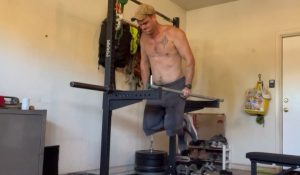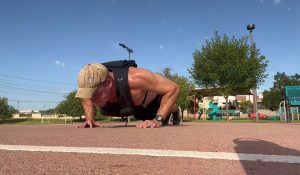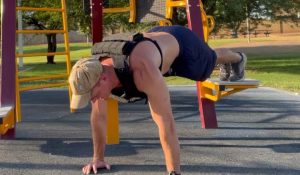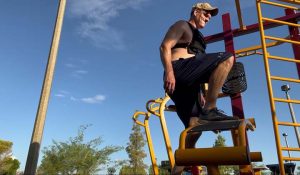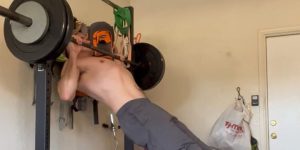Though it’s true that most folks who are utilizing so-called “body part” splits (AKA bro splits) tend to have bodybuilding-focused goals, it’s very possible to utilize this same methodology with bodyweight exercises, creating a calisthenics bro split of sorts.
What’s more is that we’ll see very similar levels of hypertrophy gains, as long as exercises are properly loaded and the appropriate amount of volume is used (10-20 sets per week, per body part).
A calisthenic bro split is a workout schedule where different major muscle groups are targeted on separate days, using basic bodyweight exercises like push-ups, pull-ups, and squats. The most typical format for a bodyweight bro split looks like this:
- Monday: Chest (decline push-ups and dips)
- Tuesday: Back (pull-ups and rows)
- Wednesday: Shoulders (inverted rows and pike presses)
- Thursday: Legs (high-rep squats and lunges)
- Friday: Arms (diamond push-ups and bodyweight curls)
What follows is a bodyweight-only bro split program I put together for folks who love the pump. After all, research shows that when we equate the volume from one program to another, manipulating only frequency, the results are largely the same.
We’ll discuss the particulars of how to make it work later. For now, let’s just lay out the program itself:
The “bro split” calisthenics program
For the workout below, we’ll focus on training each muscle group once per week. This means that we can’t get cute! Full effort in your work sets, approaching failure on each set while still leaving a repetition or two in the tank.
Since this is a bodyweight routine, we’ll be utilizing a lot of compound exercises. This is a good thing, but don’t forget which muscle you’re intended to target with each exercise.
For all of the workouts below, I recommend resting around 1-2 minutes between sets.
Equipment you’ll need:
- A place to do pull-ups
- A place to do dips
- A place to do inverted rows (likely the same implement you’re using for dips)
Monday: Chest day
Monday’s chest workout is simple. We’ll be targeting the upper chest first (since it’s a lagging body part for most people), and following it with multiple sets of dips to hit the lower chest:
- Decline “upper chest” push-ups (upper chest): 5 sets within 2-3 reps of failure
- Dips (lower chest): 5 sets within 2-3 reps of failure.
Note that this particular variation of a decline push-up is very specific – so much so that I wrote an entire article on how to hit the upper chest with push-ups. Go give that a read if you’d like to know the specifics.
Tuesday: Back day
Tuesday’s calisthenic back workout will be similar: we’ll utilize the big two when it comes to back training: pull-ups and inverted rows.
- Varied-grip pull-ups (lats and mid-traps): 5 sets within 2-3 reps of failure
- Feet-elevated inverted rows (upper traps and rhomboids): 5 sets within 2-3 reps of failure
Our pull-ups will target the lats, obviously. I say “varied grip” above because I’d typically do 1-2 sets with a particular grip and then switch to another grip. So, you could do two sets with a wide grip, two sets with a shoulder-width grip, and one or two sets with a neutral grip.
The inverted rows should be done in a reverse plank position with the feet elevated 10-12 inches. Note that you don’t have to elevate the feet, it will simply make the exercise harder and more effective. As you tire out, feel free to do your last few sets with your feet on the floor.
Wednesday: Shoulder day
Wednesday’s calisthenic shoulder workout will focus on the three heads of the deltoid, and we’ll start with the hardest muscles to target (the rear delts) and work our way forward:
- Rear delt inverted rows (rear delts): 4 sets within 2-3 reps of failure
- Bodyweight lateral raises (side delts): 3 sets within 2-3 reps of failure (per side)
- Pike push-ups or handstand push-ups (front delts / side delts): 3 sets within 2-3 reps of failure
If you’d like to learn more specifics about the technique of each exercise, I’ve written an entire article on calisthenic shoulder workouts. Go ahead and give that article a read.
In particular, learning to use inverted rows to target the shoulders was a real game changer for me. The technique looks funky, but the result is a sort of bodyweight upright row without any of the risks associated with normal upright rows. Trust me – give them a try!
Thursday: Leg day
Thursday’s leg workout will be the trickiest, since it’s generally very difficult to target the very strong muscles of the legs without adding weight. However, this workout works if you do it correctly:
- Bulgarian split squats: 3 sets of one minute per side
- Superset “constant tension” bodyweight squats (quads) with long-step reverse lunges (hamstrings / glutes) for 5 rounds of one minute each
With our single leg movement, the Bulgarian split squat, make sure to start with the weaker side, then match the number of reps with the strong side.
In this workout, we’re using time limits since it’s not typical to reach muscular failure on leg exercises without external weight – we will be relying on accumulated fatigue by going for time limits.
Friday: Arm day
On Friday, we focus on the arms using a simple antagonistic superset. Since the biceps and triceps oppose one another, we can increase the total number of sets per muscle group:
- Diamond push-ups (triceps): 10 sets to 2-3 reps in reserve
- Bodyweight curls using a towel or bar (biceps): 10 sets to 2-3 reps in reserve
- First five rounds with no rest, then take a 5-minute break
- Then complete the last five rounds with no rest
Note that if you don’t have a suspension trainer or an upright to attach a towel or rope to, then go ahead and do chin-ups instead, focusing on a mind-muscle connection with the biceps.

How to make a bro split work
Obviously, the primary goal of this style of training split is to build muscle. They can get a lot of flak in favor of the higher frequency split models that are in vogue at the moment, and they exist on the polar opposite end of the spectrum from full-body plans like heavy, light, medium calisthenic plans.
That being said, there’s actually research showing that they work well if they’re implemented properly. The key is to hit the proper volume of work while focusing on a good mind-muscle connection with the target muscle groups for the day.
Implement the following pointers to get this split to provide good muscle growth:
- As you’re doing each rep, get a good mind-muscle connection with the target muscle
- Don’t worry about rep counts! Worry about taxing the muscle properly and stopping when you’re close to failure.
- Make sure not to skip workouts when you’re on this plan – if you do, it will be two full weeks between hitting a certain body part, which will lead to sub-par results.
Why choose a calisthenic body part split over something else?
1. Bro splits are great if hypertrophy is your main goal
There’s a reason that body part splits were the main training modality amongst the bodybuilders of the 90’s (and even today, in many cases). If you’re focused on hypertrophy, then a bro split is an excellent option because it allows you to smash the target muscle.
2. Bro splits are great if you love getting a pump
This split is also an excellent option for folks who simply love getting a pump in the target muscle and then ending the workout. While I love my full-body circuits, it’s rare to truly smash an individual muscle within those workouts.
If you’re someone who’s motivated by the pump, then go ahead and do a bodyweight bro split!
3. If you know you’ll make all your workouts
For someone whose schedule is very consistent, and they know they can reliably work out five days per week, a bro split can work out great. You’ll be consistently hitting each muscle group once per week with 10-20 good work sets, and the gains will come rolling in!
Potential drawbacks of choosing a bodyweight bro split
1. You cannot skip workouts
I think the main drawback of a bro split is that you really can’t skip workouts. If you do, you’ll be going two full weeks without hitting a certain body part, meaning your growth will be uneven.
Therefore, if your schedule is up in the air sometimes, this may not be the best split for you. For people whose schedules are subject to sudden change, I almost always recommend full-body splits. That being said, even a two times per week frequency split like an upper / lower split or push, pull, legs makes more sense in this case.
2. Not great for general fitness
If you’re interested more in general fitness than hypertrophy, I would recommend doing something more along the lines of full body calisthenic splits or weighted vest circuit training, since these splits tend to lead to more metabolic stress through the whole body and tend to get the heart pumping much harder.
4. Not great if you don’t have five days per week to work out
If you’ve only got three days per week to work out, I would almost certainly recommend against a bro split since you’ll be going nine or 10 days between hitting a certain body part.
If this were the case, I would ditch the bro split in favor of a more traditional full-body, three day per week routine.
If you’ve got four days per week to work out, then the upper / lower split tends to work out the cleanest.
Making progress over time
While you can theoretically make progress on the split above for many months at a time, you’ll eventually want to increase the stress in order to continue to see progress.
I would recommend the following format of progressive overload if you’re planning to use this split in the long term:
- Weeks 1-2: Do the plan as laid out above
- Weeks 3-4: Add one set per exercise to every exercise in the plan
- Weeks 5-6: Add one more set per exercise
- Week 7: DELOAD. Do only one set per exercise
- Week 8 and beyond: start at the beginning
Using this plan, with appropriate deloads, will leave you feeling fresh on week 8 and ready to start tearing into the exercises once again.
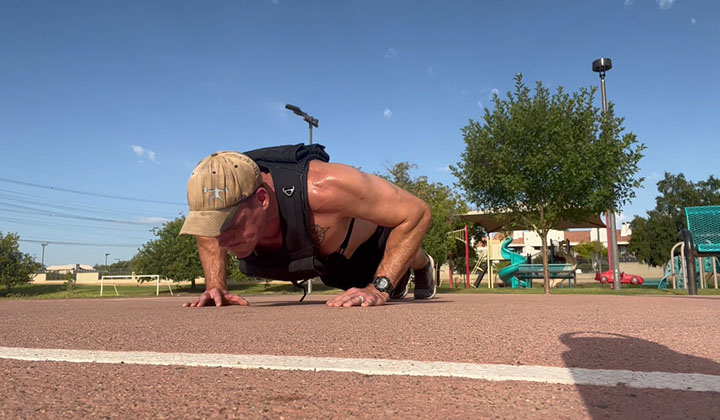
Potential modifications to the calisthenics bro split
If you simply want to bring up a certain lagging body part
If you simply want to get a certain lagging body part to grow, then simply take the workout above that applies to that body part and implement it in a higher frequency model like an upper / lower split or push, pull, legs.
For example, if a certain lifter simply wishes to build broader shoulders with calisthenics, this could be accomplished easily like this:
- Monday: Upper
- Tuesday: Lower
- Wednesday: Shoulders (taken from the bro split outlined above)
- Thursday: Lower
- Friday: Upper
6 or 7-day variations of the bro split
If you know you can reliably work out 6 or 7 days per week, then you could easily perform this bro split in a circuit like this:
- Monday: Chest
- Tuesday: Back
- Wednesday: Shoulders
- Thursday: Legs
- Friday: Arms
- Saturday: Chest
- Sunday: Back
- And so on…
This would, of course, lead to you not doing the same workouts on each day each week. However, this isn’t necessarily a problem since you’ll just do whichever workout is next on the list.
Add resistance
I make no apologies for my love of using a weighted vest to transform basic bodyweight routines into full-blown lifting sessions.
If you desire to add resistance (or you’re consistently getting more than 25 repetitions per set on a given exercise), then adding a weighted vest is one of the simplest ways to bring your repetitions down and jack the muscular tension back up.













